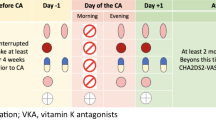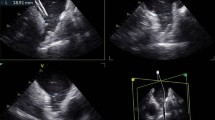Abstract
Purpose
Esophageal injury is a potential complication with radiofrequency ablation in the posterior wall of the left atrium (LA). The “box isolation” method isolates the posterior LA wall including the pulmonary veins without ablation on the posterior LA wall. This study compares the acute and long-term efficacy of the box isolation method with conventional circumferential pulmonary vein isolation (PVI) for catheter ablation of AF.
Methods
Twenty-nine patients (age 60±9 years, 62% male, 79% paroxysmal) with drug refractory AF underwent catheter ablation. Sixteen of the 29 patients (55%) underwent box isolation. Recurrence of AF was detected by checking the daily recorded rhythm strip on a portable home ECG monitor, irrespective of the symptoms. Mean follow-up duration was 10±2 months.
Results
Complete isolation of the posterior LA using box isolation lesions was achieved in three of 16 (19%) patients. The other 13 patients underwent creation of additional lesions until all PVs were isolated. Of the 16 patients who underwent box isolation, four patients (25%) had complete success, six patients (38%) had improvement, and the remaining six patients (37%) had failure. Of the 13 patients who underwent the standard PV isolation, two patients (15%) had complete success, eight patients (62%) had improvement, and the remaining three patients (23%) had failure (p=0.44).
Conclusion
In this pilot study, the efficacy of box isolation is similar to the circumferential PVI for catheter ablation of AF. Few patients achieved PVI with box method alone. Based on these results, we do not recommend the box isolation strategy.





Similar content being viewed by others
References
Roberts-Thomson, K. C., Stevenson, I., Kistler, P. M., Haqqani, H. M., Spence, S. J., Goldblatt, J. C., et al. (2009). The role of chronic atrial stretch and atrial fibrillation on posterior left atrial wall conduction. Heart Rhythm, 6, 1109–1117.
Sanders, P., Hocini, M., Jaïs, P., Sacher, F., Hsu, L. F., Takahashi, Y., et al. (2007). Complete isolation of the pulmonary veins and posterior left atrium in chronic atrial fibrillation. Long-term clinical outcome. European Heart Journal, 28, 1862–1871.
Todd, D. M., Skanes, A. C., Guiraudon, G., Guiraudon, C., Krahn, A. D., Yee, R., et al. (2003). Role of the posterior left atrium and pulmonary veins in human lone atrial fibrillation: electrophysiological and pathological data from patients undergoing atrial fibrillation surgery. Circulation, 108, 3108–3114.
Kalifa, J., Tanaka, K., Zaitsev, A. V., Warren, M., Vaidyanathan, R., Auerbach, D., et al. (2006). Mechanisms of wave fractionation at boundaries of high-frequency excitation in the posterior left atrium of the isolated sheep heart during atrial fibrillation. Circulation, 113, 626–633.
Lin, W. S., Tai, C. T., Hsieh, M. H., Tsai, C. F., Lin, Y. K., Tsao, H. M., et al. (2003). Catheter ablation of paroxysmal atrial fibrillation initiated by non-pulmonary vein ectopy. Circulation, 107, 3176–3183.
Markides, V., Schilling, R. J., Ho, S. Y., Chow, A. W., Davies, D. W., & Peters, N. S. (2003). Characterization of left atrial activation in the intact human heart. Circulation, 107, 733–739.
Sueda, T., Nagata, H., Orihashi, K., Morita, S., Okada, K., Sueshiro, M., et al. (1997). Efficacy of a simple left atrial procedure for chronic atrial fibrillation in mitral valve operations. The Annals of Thoracic Surgery, 63, 1070–1075.
Kumagai, K., Muraoka, S., Mitsutake, C., Takashima, H., & Nakashima, H. (2007). A new approach for complete isolation of the posterior left atrium including pulmonary veins for atrial fibrillation. Journal of Cardiovascular Electrophysiology, 18, 1047–1052.
Calkins, H., Brugada, J., Packer, D. L., Cappato, R., Chen, S. A., Crijns, H. J., et al. (2007). HRS/EHRA/ECAS expert Consensus Statement on catheter and surgical ablation of atrial fibrillation: recommendations for personnel, policy, procedures and follow-up. A report of the Heart Rhythm Society (HRS) Task Force on catheter and surgical ablation of atrial fibrillation. Heart Rhythm., 4, 816–861.
Fuster, V., Rydén, L. E., Cannom, D. S., Crijns, H. J., Curtis, A. B., Ellenbogen, K. A., et al. (2006). ACC/AHA/ESC 2006 guidelines for the management of patients with atrial fibrillation: a report of the American College of Cardiology/American Heart Association Task Force on Practice Guidelines and the European Society of Cardiology Committee for Practice Guidelines. Circulation, 114, 700–752.
Cheema, A., Dong, J., Dalal, D., Vasamreddy, C. R., Marine, J. E., Henrikson, C. A., et al. (2006). Long-term safety and efficacy of circumferential ablation with pulmonary vein isolation. Journal of Cardiovascular Electrophysiology, 17, 1080–1085.
Weerasooriya, R., Jaïs, P., Hocini, M., Scavée, C., MacLe, L., Hsu, L. F., et al. (2005). Effect of catheter ablation on quality of life of patients with paroxysmal atrial fibrillation. Heart Rhythm, 2, 619–623.
Dorian, P., Paquette, M., Newman, D., Green, M., Connolly, S. J., Talajic, M., et al. (2002). Quality of life improves with treatment in the Canadian trial of atrial fibrillation. American Heart Journal, 143, 984–990.
Ware, J. E., Jr., & Gandek, B. (1998). Overview of the SF-36 health survey and the International Quality of Life Assessment (IQOLA) project. Journal of Clinical Epidemiology, 51, 903–912.
Jenkins, L. S., Brodsky, M., Schron, E., Chung, M., Rocco, T., Jr., Lader, E., et al. (2005). Quality of life in atrial fibrillation: the Atrial Fibrillation Follow-up Investigation of Rhythm Management (AFFIRM) study. American Heart Journal, 149, 112–120.
Scherr, D., Dalal, D., Henrikson, C. A., Spragg, D. D., Berger, R. D., Calkins, H., et al. (2008). Prospective comparison of the diagnostic utility of a standard event monitor versus a “leadless” portable ECG monitor in the evaluation of patients with palpitations. Journal of Interventional Cardiac Electrophysiology, 22, 39–44.
Tamborero, D., Mont, L., Berruezo, A., Matiello, M., Benito, B., Sitges, M., et al. (2009). Left atrial posterior wall isolation does not improve the outcome of circumferential pulmonary vein ablation for atrial fibrillation: a prospective randomized study. Circ Arrhythm Electrophysiol, 2(1), 35–40.
Acknowledgments
Dr. Karuna Chilukuri was supported by The Norbert and Louise Grunwald Cardiac Arrhythmia Research Fund. Dr. Daniel Scherr was supported by the Erwin Schroedinger Research Grant (J2559) of the FWF—Austrian Science Fund. The Johns Hopkins Atrial Fibrillation Program is supported by the Francis Chiaramonte Foundation.
Author information
Authors and Affiliations
Corresponding author
Additional information
Clinical trial number:
NCT01091597
Rights and permissions
About this article
Cite this article
Chilukuri, K., Scherr, D., Dalal, D. et al. Conventional pulmonary vein isolation compared with the “box isolation” method: a randomized clinical trial. J Interv Card Electrophysiol 32, 137–146 (2011). https://doi.org/10.1007/s10840-011-9587-8
Received:
Accepted:
Published:
Issue Date:
DOI: https://doi.org/10.1007/s10840-011-9587-8




